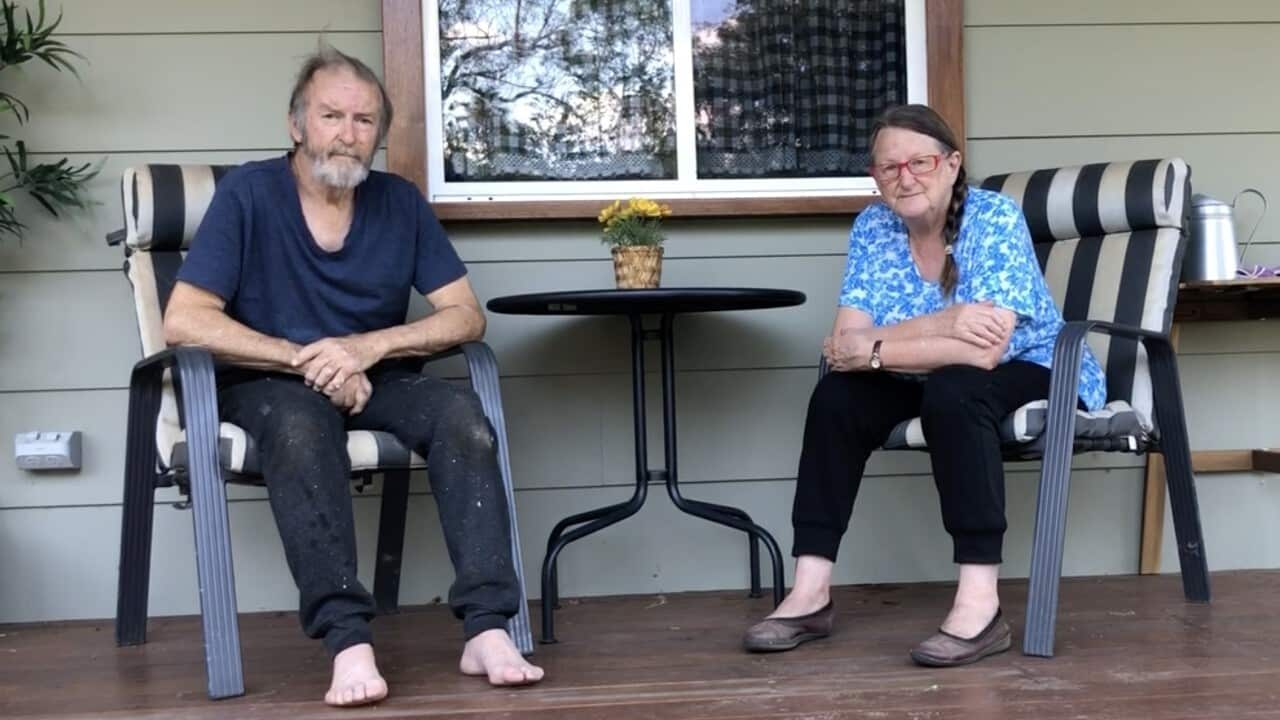Key points
- Insurers have been increasing premiums across the board in recent years.
- For those in zones at risk of floods, fire or cyclones, premiums have for many become unaffordable.
- The Climate Council estimates one in 25 properties will effectively become uninsurable by 2030.
In December 2019, Judith and Paul Collins were forced to flee their home in Buxton in the NSW Southern Highlands before it burned to a crisp. Initially hopeful their insurance payout would cover the rebuild costs, they were left heartbroken.
The 70-year-olds, who have both been on the disability pension for 20 years, had tried to cut costs on their premiums, so received almost $30,000 less than they expected.
They couldn't afford to buy a property anywhere else so were forced to rebuild on their land, which was suddenly considered at high risk of fire. Not only did this mean an extra $1,200 on their annual insurance premium, bringing it to $3,357, it also meant they had to make their home fire resistant, which would cost them $18,000.
Then they were faced with a 40 per cent increase in construction materials due to supply shortages during the pandemic.
They were left unable to afford a builder.
"My husband has got kidney disease and I have a rare spinal disease, and we've been working on the property approximately seven to 12 hours a day, seven days a week, for two-and-a-half years," Judith told SBS News.
With both of them living with life-threatening illnesses, they want to have the house ready to sell as soon as possible.
"If we go on to a single pension, we cannot afford the insurance."

Judith and Paul Collins say not only has the insurance premium for their property gone up, they are also required to make their rebuilt home fire resistant, which is costing them thousands of dollars. Source: SBS News
Her house now little more than a skeleton, she would like to relocate somewhere above the flood level but housing and insurance costs mean this isn't an option her. So the 70-year-old plans to rebuild, though she's still waiting for her insurer to pay out and she's anxious about what her insurance costs will look like in the future.
She expects they will be unaffordable.
"I have to rebuild then I'll have to get reinsured and I still don't know what that bill will look like," she told SBS News.

Susan Conroy would like to relocate somewhere else above the flood level but housing and insurance costs make this option too expensive for her.
"People are worried about their next insurance premiums … it sounds to me like most people in the younger generation can't afford them," she says.
Ms Conroy says people are also anxious that the grants and payouts available are insufficient to prepare their homes for another big flood.
"My insurer is proposing using plasterboard, which we know will turn into sodden papier-mâché [in the event of a flood]. Many of us can't afford water-resistant materials like villaboard or marine ply and none of us believe it will be the last flood of that magnitude."
Why are insurance premiums skyrocketing?
Insurers have been rising premiums for everyone in recent years — some as much as 10-11 per cent per annum. This is partly due to inflation, partly due to mounting reinsurance rates worldwide and partly due to the climate-related risks Australia is facing.
"Reinsurers [companies that insure insurance companies], who are global players, are re-rating Australia," Mat Jones, general manager of public affairs at the Insurance Council of Australia (ICA), told SBS News. "Apart from earthquakes and volcanoes, we get the brunt of all of the extreme weather events. We've had flooding, cyclones and terrible fires .. and that risk in Australia is putting upward pressure on premiums."
The insurance bill for storms and floods since January 2020 has now topped $12.3 billion from 788,000 claims — or the equivalent of one in 25 adult Australians, according to the ICA.
And the cost of the February to March floods in 2022 has now reached more than $5.65 billion, making it the most expensive natural disaster in Australia’s history.
Since then, some people in flood-prone areas such as Lismore or the Hawkesbury-Nepean plains in Western Sydney have reportedly seen premiums rise to $20,000 to $30,000 per year.
There were many uninsured houses in Australia even before the recent disasters. With such costly premiums, there are likely to be many more.
Mr Jones said insurers want to keep insurance affordable; it's in their interests to have as many people in the insurance pool as possible. But with the worsening extreme weather events, they've been forced to re-rate properties to recoup costs.
"We're having floods that are higher than we've ever seen before, cyclones coming further south than they've ever come before, and fires that are more intense than they've ever been before.
"We have to re-rate some of these properties."
Will insurance costs keep rising?
The increasing costs of maintenance, repair and replacement to properties as a result of worsening extreme weather will see insurance premiums continue to rise, the Climate Council says.
In its report , it says approximately 520,940 properties, or one in every 25, will be ‘high risk’ — having annual damage costs from extreme weather and climate change that make them effectively uninsurable — by 2030.
In addition, 9 per cent of properties (one in 11) will reach the ‘medium risk’ classification by 2030, with annual damage costs that equate to 0.2-1 per cent of the property replacement cost, which makes these properties at risk of becoming under-insured.
The shows the problem increasing dramatically by 2050 and then 2100, with the latter map depicting a land of perilous red.
Economist Nicki Hutley is a councillor on the Climate Council. She says the statistics are "completely alarming".
"It's something that we should have been aware of by listening to climate scientists. This just puts it down in black and white. And sometimes you need to do that for people to take notice."
"If you go forward in time, everything gets worse, because on the current emissions trajectory, things will get worse," Ms Hutley told SBS News. "Even if we do more in policy, it'll still get worse before it starts to plateau."
The report says in extreme instances, areas may even become "uninhabitable".

Worsening extreme weather means increased costs of maintenance, repair and replacement to properties. With this risk increasing, insurers are raising premiums to cover the increased cost of claims and reinsurance. Source: SBS News
"There are still new housing developments going into areas that are known to be subjected to these risks, and there really aren't standards in place that ensure that housing in Australia is built to a basic resilience standard, and that our planning rules and our financial services are fit for what we need."
Mr Jones at ICA says that "technically, there's no place in Australia that's uninsurable".
"But there are a growing number of locations where the cost of insurance against a particular peril such as a flood or cyclone is such that it's effectively out of reach for most people," he added.
Which areas will be the worst affected?
The Climate Council has produced a ranking of the top 10 most 'at risk' electorates from climate change and extreme weather events (bushfires, extreme wind and flooding), based on the percentage of ‘high risk’ properties in each federal electorate.
The top 10 most at-risk federal electorates by 2030 are Nicholls (Vic), Richmond (NSW), Maranoa (QLD), Moncrieff (QLD), Wright (QLD), Brisbane (QLD), Griffith (QLD), Indi (Vic), Page (NSW) and Hindmarsh (SA).
Ms Hutley says high-risk properties at this stage are mainly clustered in riverine areas, with coastal areas expected to come under increasing threat over coming decades and those living on the edge of national parks to be increasingly threatened by fire.
Unfortunately, it's those who are already financially vulnerable who will be most at risk, she adds.
"People often buy in these high-risk areas because housing is cheaper, because of the risks. And you end up having an already economically vulnerable population then becoming even more vulnerable."
What are governments doing?
In 2022 the federal government’s Disaster Ready Fund committed $1 billion to be made available over five years from 2023 to help communities across Australia protect themselves against the impacts of natural hazards, with funding to be matched by the states and territories.
The money will go on infrastructure to make communities more resilient, such as flood levees and seawalls, and grant programs that provide funding for people to retrofit their homes to make them more resistant to fires, floods or cyclones.
At a National Cabinet meeting in late 2022, senior ministers agreed that developing on floodplains "needs to end” and they're now in the process of developing a national standard for considering disaster and climate risk, while treasures are tasked with considering "ways to improve insurance affordability". They will report back to National Cabinet in 2023.

Many people living on floodplains have seen insurance premiums for their properties become prohibitively expensive. Source: AAP / Murray McCloskey
At the same time, it's about driving down emissions so the situation can have a chance of stabilising, they add.
What can homeowners do?
Ms Woods said homeowners should themselves "invest in making their asset more resilient", which can also help to lower insurance premiums.
"These things can cost more money upfront, but modelling shows that you will save over the life of your house," she said.
In areas of high-risk fire, this may be using building techniques and materials that make homes more fire-resistant, enclosing the bottom level of the home, or removing trees in close proximity. In flood-prone zones, it might be raising the house and retrofitting it with waterproof membranes or water-resistant materials. In cyclone-prone areas, it may entail battening roofs and putting shutters over windows and doors.

Nearly a year after the floods, Susan Conroy still hasn't received her insurance payout to enable her to rebuild. Source: SBS News
"We need a national framework and a state government framework that enables local communities to get access to money and plans so that they can be ready for climate disaster."
What should homebuyers do?
Ms Woods and Ms Hutley suggest prospective homeowners do some research on the climate risk of a property in the same way they would do a building survey or pest inspection. provides reports on its website while local councils are increasingly offering information and modelling around climate risk.
Mortgage lenders are increasingly assessing loans according to the risk of climate-related events, too. A 2022 Commonwealth Bank climate risk assessment of its home loan portfolio found about 38,000 properties (with mortgages equalling $11 billion) had a high risk of exposure to cyclones, while 56,000 properties ($19 billion) were at risk of floods and 5,000 ($2 billion) at risk of fire.
Mr Jones at ICA advises people to check insurance premiums on the home before they buy, and suggests they shop around.
"It's always worth talking to insurers about what mitigation measures may have an impact on their premiums, such as using government grants to retrofit. And do talk to them about increasing your excess, which could have an impact on the amount you pay," he said.
Climate-related checks will have to become normal for homeowners and homebuyers, Ms Woods added.
"Regardless of the mitigation action that we take now, there is further warming already locked in. So anyone buying a home they want to live in for a couple decades will need to factor that in."



